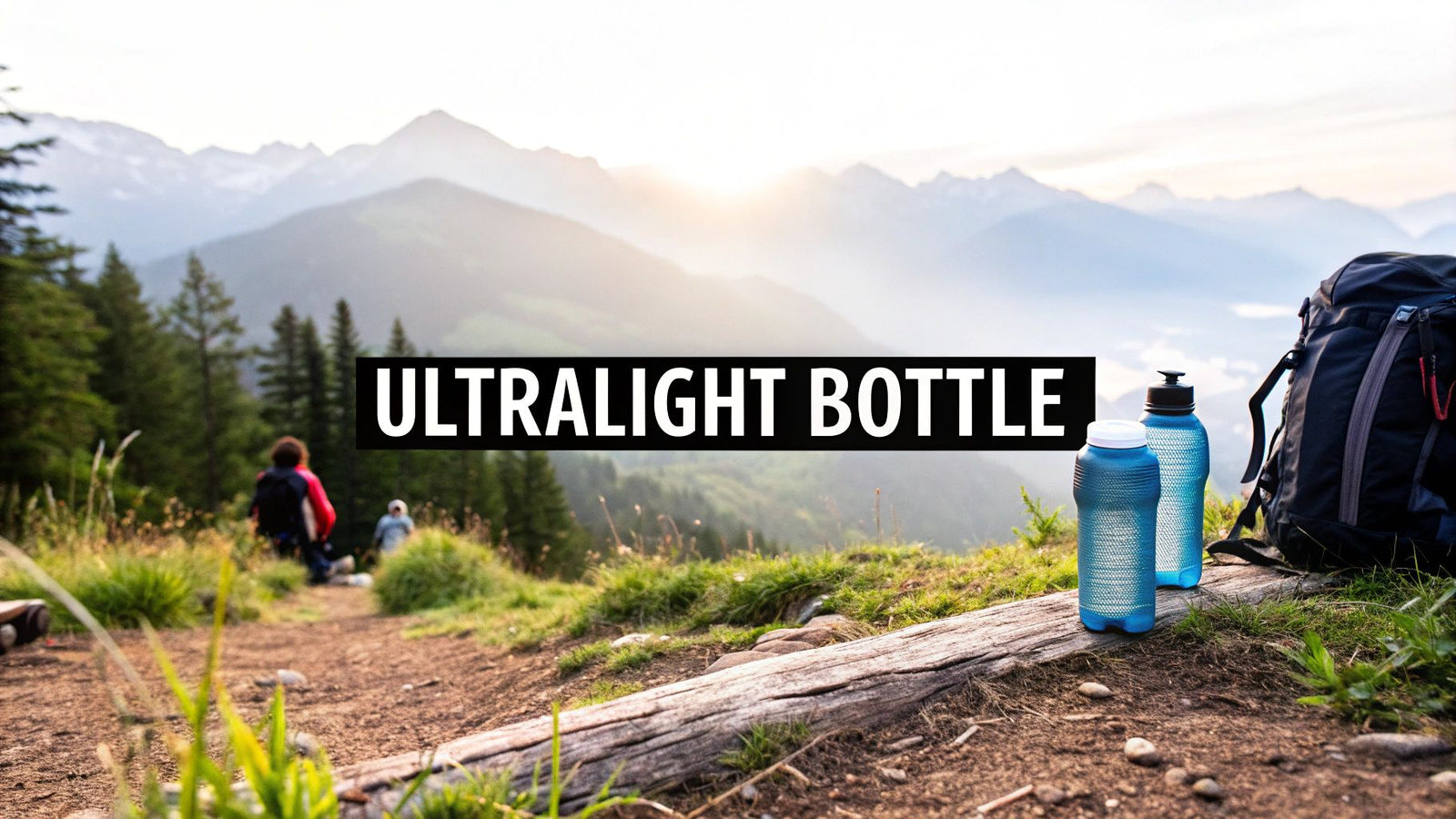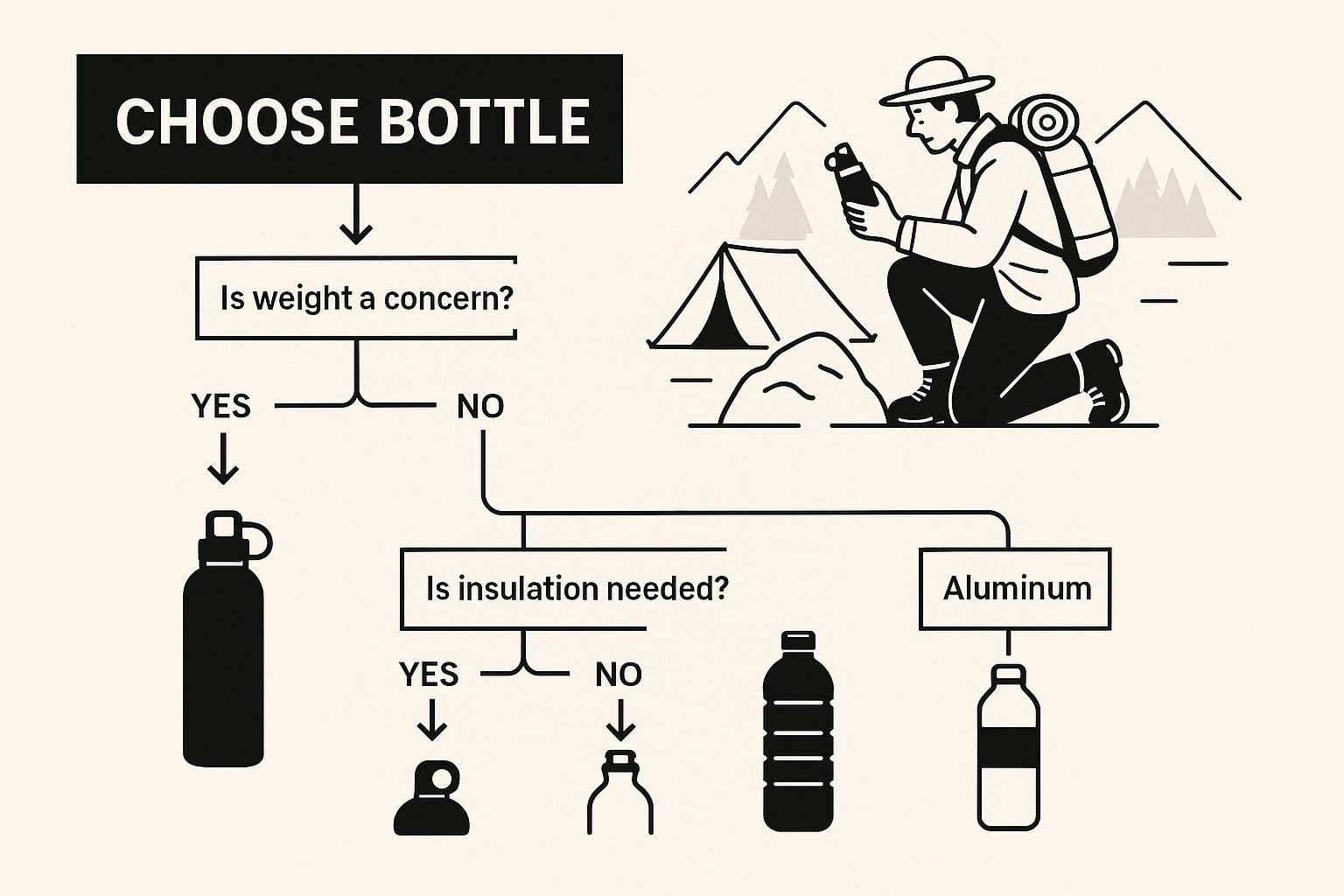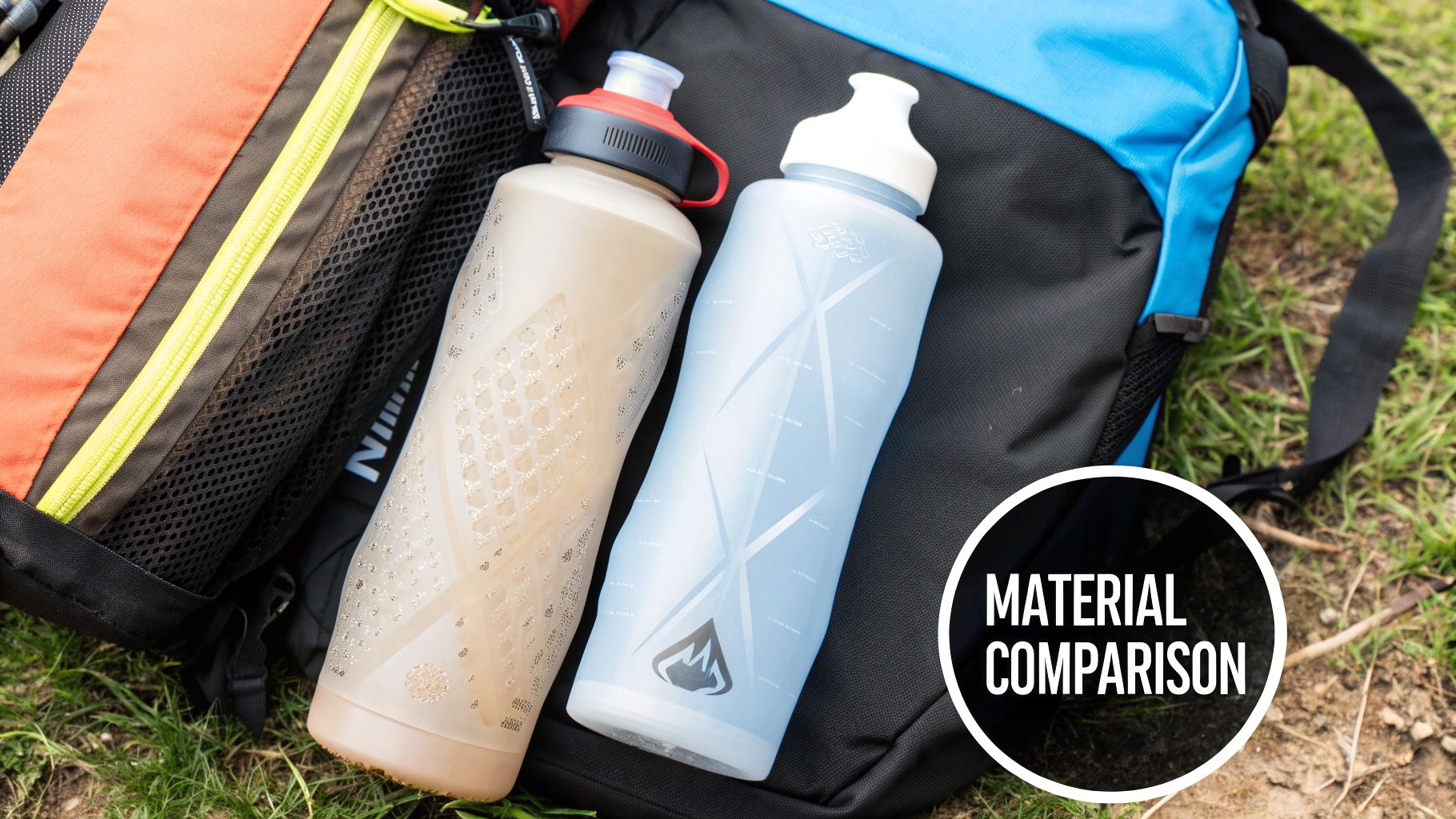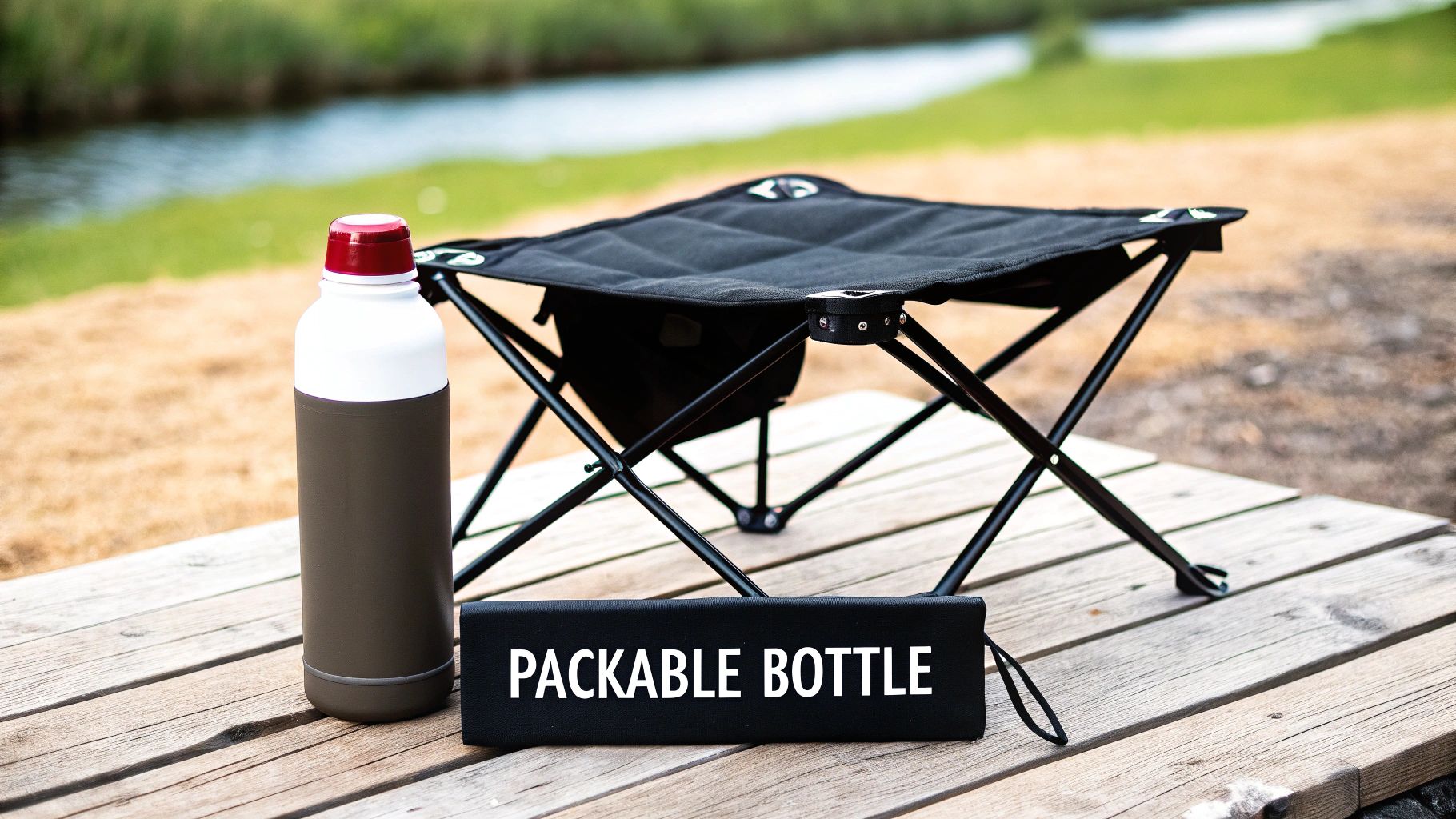Choosing a Lightweight Backpacking Water Bottle

Picking the right lightweight backpacking water bottle isn't just about grabbing any old container. It’s a deliberate choice that shapes your entire trail experience, balancing crucial factors like weight, space, and simple convenience. The perfect bottle for you really comes down to your hiking style and where your adventures take you.
How to Choose Your Backpacking Water Bottle
Every single ounce matters when you're carrying your world on your back. Deciding which water bottle to bring along is a strategic move that affects your pack weight, how easily you can grab a drink on the move, and even how much room you have left for other gear. Think of it as the cornerstone of your entire hydration setup.
This push for lighter, smarter gear is happening all across the outdoor industry. In fact, the reusable water bottle market is projected to grow significantly, driven by consumers who want products that are both sustainable and practical. This demand fuels innovation, giving us backpackers more specialized choices than ever. You can discover more insights about this growing market and see how it’s changing product design.
Matching a Bottle to Your Hiking Style
First things first: you have to know what you need. A thru-hiker tackling the Pacific Crest Trail has a completely different set of needs than someone heading out for a quick weekend escape to a local state park.
Let's break it down with a few practical examples:
- The Day Hiker: For a quick 5-mile loop, a tough, rigid bottle is usually the way to go. It’s easy to drink from, a breeze to clean, and can handle being dropped on a rocky path without a second thought. You value simplicity and durability over saving a few ounces.
- The Weekend Backpacker: For a 2-3 day trip, a hybrid system works best. Imagine using a rigid bottle for quick sips while hiking, and packing a collapsible one like the HYDAWAY bottle to hold extra water at camp. Once it’s empty, it packs down tiny for the hike home, freeing up space for souvenirs or just making packing easier.
- The Ultralight Thru-Hiker: When you’re covering 20+ miles a day, packability and weight are everything. A soft or collapsible bottle that shrinks as you drink is the gold standard here, saving precious space and getting rid of that annoying sloshing sound.
This infographic does a great job of showing how different hiking styles lead to different bottle choices.

As you can see, there’s no single "best" bottle—only the best bottle for your adventure. If you take a moment to think honestly about how you hike, you'll be able to zero in on the perfect option and choose with confidence.
Comparing Water Bottle Materials

The material of your lightweight backpacking water bottle is the foundation for everything else. It’s what dictates the bottle’s weight, how tough it is, and even how your water tastes miles down the trail. Getting this choice right is like picking the perfect tool for a job—each one has its own specific strengths.
Think of a classic rigid bottle as your trusty hardcover book: durable, reliable, and always ready to go. On the other hand, a soft flask is more like an e-reader, shrinking and getting more compact the more you use it. Understanding these little differences is key to finding the bottle that fits your hiking style.
Let’s break down the most common materials you’ll run into and what they really mean for your adventures out on the trail.
Plastics: Hard and Soft
Plastic is, without a doubt, the king of the lightweight backpacking world. But not all plastics are created equal. The two main players you'll see are Tritan for rigid bottles and Thermoplastic Polyurethane (TPU) for the soft, collapsible kind.
-
Tritan (Hard Plastic): This is that tough, crystal-clear material you see in popular rigid bottles. It’s known for being impact-resistant and, maybe more importantly, it won't hold onto the flavor of that electrolyte mix you used last week—a frustrating issue known as "flavor ghosting." If you need a bottle that can survive being dropped on a rocky scramble, Tritan is your best bet.
-
TPU (Soft Plastic): Flexible and surprisingly durable, TPU is the go-to for soft flasks and collapsible bottles. Its superpower is packability; it gets smaller as you drink. Imagine finishing your water at camp and folding your bottle down to the size of your palm. That's the magic of TPU.
A lot of seasoned backpackers take a hybrid approach, which really gives you the best of both worlds. For instance, you could carry a rigid Tritan bottle in your pack's side pocket for easy sipping on the move and have a large-capacity collapsible bottle made of TPU or silicone packed away as your main water reservoir for camp.
Food-Grade Silicone: The Collapsible Star
Silicone is the other big player, especially when it comes to collapsible gear. It’s known for being incredibly flexible, tough, and completely taste-neutral. This is the stuff that allows for all sorts of clever, space-saving designs.
A perfect real-world example is the HYDAWAY collapsible bottle, which uses food-grade silicone for its unique accordion-style design. When it’s time to pack up and head home, this bottle squishes down to just over an inch thick. This means it fits perfectly into your life—whether that’s saving space on a multi-day trip, slipping it into your carry-on for a flight, or tossing it in your gym bag without the bulk. You can carry a full 25 ounces when you need it, and it practically disappears when you don't.
Stainless Steel: The Rugged Outlier
Okay, so it’s heavier than plastic or silicone, but stainless steel definitely has its place. It’s pretty much indestructible and offers amazing temperature control, keeping your water ice-cold for hours on a hot day. If your trip involves a scorching hike in a national park like Zion or you just value durability above all else, the extra weight of a stainless steel bottle might be a trade-off you're willing to make.
Why Collapsible Bottles Are a Game Changer

For anyone serious about ultralight backpacking, pack space is the ultimate currency. Every single square inch you can save means more room for critical gear—or just a lighter, more comfortable load on your back. This is exactly where collapsible and soft water bottles enter the picture, completely changing the game.
Picture this: you've just finished the last of your water at the campsite after a long day's hike. Instead of being stuck with a bulky, empty plastic container for the rest of your trip, you simply fold your bottle down to the size of a hockey puck and tuck it into a pocket. That’s the magic of a collapsible lightweight backpacking water bottle.
Maximizing Pack Space and Efficiency
The biggest win with a collapsible bottle is, without a doubt, its incredible space-saving design. A rigid bottle takes up the exact same amount of real estate in your pack whether it’s full to the brim or bone dry. Collapsible models, on the other hand, shrink as you drink.
This dynamic approach to volume is a massive advantage for anyone looking to truly optimize their pack. It also puts an end to that annoying sloshing sound you get from a half-empty rigid bottle. Because the flexible material conforms to the water level, you get a much quieter and more stable load as you hike, which makes a surprising difference on a long day.
Collapsible bottles are the perfect example of "pack it in, pack it out" efficiency. They let you carry a ton of water for the trail ahead, then virtually disappear when they're empty, making your hike back to the car that much lighter and more compact.
How HYDAWAY Redefines Packability
The HYDAWAY collapsible bottle is a prime example of this smart design in action. Its unique, accordion-like body allows it to flatten down to just over an inch thick. This means you can carry a full 25 ounces when you need it, and then stash it almost anywhere when you don’t—a side pocket, your pack’s lid, or even the pocket of your pants.
For the modern backpacker, this kind of flexibility is priceless. You can start your day with two full HYDAWAY bottles and, as you drink your water, collapse one and pack it completely out of the way. This adaptable approach helps you manage both weight and space as you move through your trip, fitting perfectly into the minimalist needs of today's hiker. It's the bottle that’s there when you need it and gone when you don't.
The growing buzz around this category isn't just hype; it reflects a huge market trend. The global reusable water bottle market is valued in the billions of dollars as of 2024 and is expected to keep climbing. That's a lot of hikers embracing these space-saving solutions. A collapsible bottle isn't just a container—it’s a strategic piece of gear that makes your entire backpacking system smarter and more efficient.
Balancing Water Capacity and Pack Weight
Figuring out exactly how much water to carry is one of backpacking’s oldest puzzles. Haul too little, and you’re staring down the barrel of dangerous dehydration. Carry too much, and every single step feels like a battle against the unnecessary weight digging into your shoulders.
The secret isn’t some magic number. It’s about building a smart, adaptable strategy that changes with every trip. Your plan should always consider three core factors: the climate you're hiking in, how often you'll find water sources, and the sheer length of your trek. A hot, exposed desert trail demands a much bigger water reserve than a shady forest path dotted with flowing streams.
Tailoring Your Hydration to the Trail
Let’s ditch the old, rigid "one liter per two hours" guideline and get a little more strategic. A flexible approach that mixes and matches different types of bottles is the best way to prepare for any situation without being weighed down.
Think about these real-world scenarios:
- Hot Desert Hike: Out here, water is life, and your body is losing it fast. A smart setup is a primary rigid bottle for sipping on the move, paired with a larger-capacity HYDAWAY collapsible bottle. This HYDAWAY acts as your backup reservoir—giving you peace of mind without permanently hogging space in your pack.
- Mountain Forest Trek: With reliable streams every few miles, you can afford to travel lighter. A smaller lightweight backpacking water bottle combined with a trusty water filter, like a Sawyer Squeeze or Katadyn BeFree, is a killer combination. You just filter and refill as you go.
The goal is to create a dynamic system. Instead of lugging four liters of water from the trailhead, you might carry one liter and simply have the capacity for four. This is where collapsible bottles really shine, offering volume when you need it and practically disappearing when you don’t.
Creating a Flexible Hydration System
Building the right system is all about combining the strengths of different pieces of gear. More often than not, a hybrid approach works best, giving you options for whatever the trail decides to throw at you. Many seasoned backpackers carry one bottle for drinking and a separate, often larger, collapsible container for camp water or for bridging those long, dry stretches between sources.
For example, you could use a 25 oz HYDAWAY bottle as your main go-to for drinking. When you reach a reliable stream just before a long, dry ridge walk, you can fill it to the brim. Once you’ve used that water, it squishes down to nothing, freeing up precious space and shedding weight. This makes it an invaluable part of your gear, helping you act on your need to stay hydrated without being weighed down.
This exact approach is a cornerstone of any effective ultralight camping gear list because it directly cuts down your base pack weight.
Ultimately, balancing capacity and weight isn't about finding one perfect bottle. It's about creating a versatile hydration plan that keeps you safe, light on your feet, and ready for anything.
How to Care for Your Hiking Water Bottle
Keeping your lightweight backpacking water bottle clean is your number one defense against funky-tasting water and trailside sickness. It's a simple habit to get into, but it’s absolutely essential for making sure your water tastes fresh and your gear lasts for many seasons to come.
If you neglect your bottle, you're rolling out the welcome mat for bacteria and mildew, which just love those damp, dark environments. A quick rinse at the end of a hiking day is a great start, but a thorough cleaning when you get home is what really protects your health and your gear investment.
On-the-Trail Maintenance
You don’t need to do a full scrub-down while you're still out backpacking. Just a few simple moves can make a world of difference in preventing grime from building up in the first place.
- Daily Rinse: Before you fill up at a stream or spring, give your bottle a quick swirl with a little clean water. This helps knock loose any sediment or yesterday's drink mix.
- Air It Out: Whenever you empty your bottle at camp, leave the lid off overnight. Letting it dry completely is the single best way to stop mildew before it even thinks about starting.
- Clean Hands Only: Always try to wash or sanitize your hands before touching the mouthpiece or the inside of your bottle. It's an easy way to avoid introducing new germs.
Deep Cleaning at Home
Once you’re back and unpacked, it’s time to give your bottle a proper deep clean. This will get rid of any lingering bacteria and finally neutralize those stubborn flavors from sports drinks or electrolyte powders.
For a basic, effective clean, just use warm, soapy water and a good bottle brush to scrub the inside walls and all the threads on the cap. If you need to bring out the big guns for a tougher job, a mix of water and white vinegar or a few drops of unscented bleach works wonders. Just be absolutely sure to rinse it thoroughly afterward so you're not tasting cleaning solution on your next trip.
The design of your bottle really matters when it comes to cleaning. Bottles with wide-mouth openings, like the HYDAWAY collapsible bottle, are so much easier to scrub and inspect, making sure you can get into every last nook and cranny. Better yet, they're top-rack dishwasher safe, which makes post-adventure cleanup a total breeze. This fits perfectly into a busy life—just toss it in the dishwasher, and it’s ready for your next trip.
Proper storage is the final, critical step. After cleaning, make absolutely sure your bottle is 100% dry before you put the cap back on. Storing a bottle with even a tiny bit of moisture inside is a perfect recipe for mold. Just leave it disassembled on a drying rack for a day or two to get it completely arid. That way, it'll be pristine and ready for your next adventure.
Sustainable Choices for Eco-Conscious Hikers
Every single piece of gear you carry into the wild has an environmental story. Your choice of a lightweight backpacking water bottle is a real chance to make a positive impact on the trails you love, shifting away from a throwaway mindset toward something much more intentional.
It really comes down to looking beyond the price tag and considering the entire lifecycle of a product. A tough, well-made bottle that lasts for years prevents countless single-use plastics from ever needing to be made in the first place. Honestly, choosing gear that’s built for the long haul is one of the most effective ways to hike sustainably.
Durability as a Sustainable Practice
Let's be real: the most eco-friendly bottle is the one you don't have to keep replacing. When you invest in a high-quality, durable product like a HYDAWAY bottle, you're directly cutting down on future waste. Its tough, food-grade silicone construction is built to handle the bumps and scrapes of the trail, making sure it stays a reliable part of your kit for adventure after adventure.
This way of thinking is part of a bigger shift we're seeing. The global water bottle market is projected to reach new highs in the coming years, and a big reason for that growth is a rising environmental awareness among consumers like you. As more of us get out on the trails, the demand for sustainable, reusable gear is only going to grow. You can actually see the full analysis of this growing market and its environmental drivers to get a sense of the trend.
By choosing a reusable bottle designed for a long life, you actively participate in a circular economy. You're not just buying a product; you're investing in a solution that minimizes your environmental footprint with every single refill.
Making an Impact Beyond the Trail
Your commitment to sustainability doesn't have to end when you leave the trailhead. Using a reusable bottle in your daily life reinforces good habits and helps make reducing waste the new normal. A collapsible HYDAWAY bottle is perfect for this—it easily tucks into a gym bag, work tote, or carry-on, making it simple to say no to single-use plastics wherever you find yourself. This lets you act on your desire to be more eco-friendly every single day.
These small, consistent choices really do add up to a significant impact. For more great ideas, learn how to reduce plastic waste in all areas of your life. At the end of the day, picking the right gear is about more than just what it does—it’s about preserving the wild places that inspire us all.
Ready to make a sustainable upgrade to your hydration system? The collapsible, durable, and ultra-packable bottles from HYDAWAY are designed to adventure with you for years to come. Find your perfect adventure companion at myhydaway.com and start your journey toward lighter packs and a lighter footprint.



